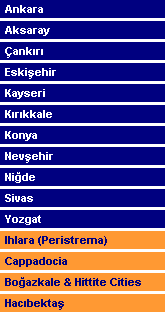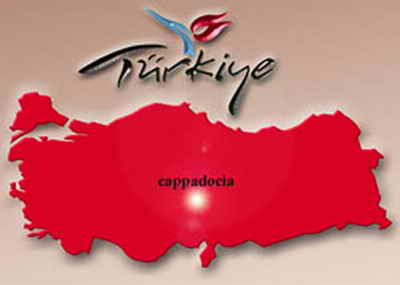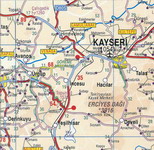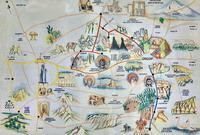| Cappadocia... |
|
Cappadocia is a picture drawn on the earth by nature, it is a poem. Cappadocia, which is situated within the triangle of
Nevsehir, Aksaray and Kayseri is bounded by Erciyes with a height of 3,916 m (12,848 ft) in the east and by Hasandag, a
volcanic mountain of 3,253 m (10,673 ft) high in the south. The tough rocks, formed by the lava spurted by these two
mountains during geological times, had kept on taking constantly changing shapes with kind effects during the course of
time, and the wonders of the world of today were created. During the early times of the spread of Christianity, the people
who needed to hide themselves from the Arab raids, carved out these tough rocks thus constructing churches and built
underground cities to defend themselves against the raids. The settlements in Cappadocia had come into existence, mostly
in the valleys of Göreme, Ihlara and Soganli. The people who had settled here, worshipped in the churches that they carved
out of the rocks, and they dealt with agriculture to meet their own needs. The water sources in the valleys made this
region productive. The most intensive settlement was in the vicinity of the township of Göreme. It is possible to see many
churches together today in the locality made into an open air museum. Let us begin discussing the churches in Cappadocia,
by describing the churches in this open air museum. In Göreme, at a distance of 7 km (4.3 miles) from Ürgüp, the first
ancient structure that appears in front of us is the Maidens Monastery. The monastery, belonging to the first half of the
11th century, and is an interesting building of six stores. The Chapel of St. Basil is situated on the opposite
side of the promenade road in the museum. The Church with Apple, one of the most important churches in Göreme, appears in
sight thereafter. The church, planned in the shape of a closed Greek cross, ends with three abscissas. The church belongs
to the 12th century and the frescos in it display the scenes based on the contents of the Bible and also
inspired by the Pentateuch. The Church of St. Barbara is situated beyond the Church with Apple. In this church which
belongs to the first half of the 11th century and the descriptions of Pontacrator Christ, Georgios, Theodoros
and Saint Barbara are worthy of attention. The Church with Snake, situated here, also belongs to the 11th
century and the scene of Deisis is displayed on its long wall.
|
|

|


















 Click here for the "Tourmap"...
Click here for the "Tourmap"...
 Source : "Ataman Hotel"... Click here...
Source : "Ataman Hotel"... Click here...









